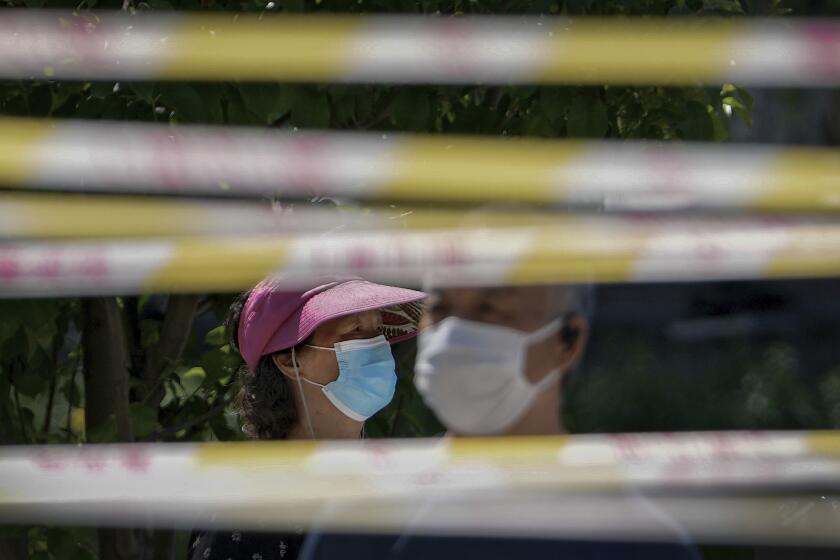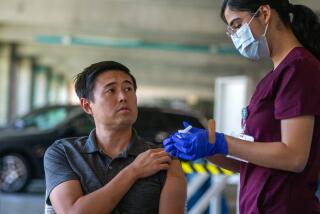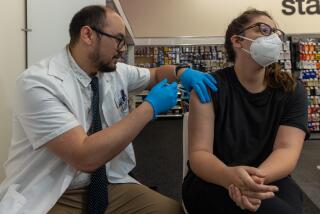COVID, flu, RSV on the rise in California. Is another ‘tripledemic’ coming?

Respiratory virus season is ramping up in California, prompting health officials to renew their calls for residents to get vaccinated in hopes of reducing potential pressure on health systems across the state.
While conditions so far are nowhere near as daunting as last autumn — when hospitals labored under the strain of a “tripledemic” spawned by wide simultaneous circulation of COVID-19, flu and respiratory syncytial virus — the transmittable trio is on the rise.
Data show new COVID and flu hospital admissions are increasing in California, and Fresno County was forced to take steps last month to stem a tide of patients arriving in its emergency rooms, instructing ambulances to not transport patients to hospitals if they are stable and not suffering from an emergency.
Nationally, “RSV season is in full swing. The flu season is just beginning across most of the country, though accelerating fast. And while we’re seeing relatively low levels of COVID, COVID is still the primary cause of new respiratory hospitalizations and deaths, with about 15,000 hospitalizations and about 1,000 deaths every single week,” Dr. Mandy Cohen, director of the U.S. Centers for Disease Control and Prevention, told a House of Representatives subcommittee last week.
Of the three viruses, RSV is the most concerning in California in terms of community transmission, said Dr. Peter Chin-Hong, an infectious diseases expert at UC San Francisco. In Los Angeles County, for data released on Thursday, 13% of specimens tested for RSV came back positive, up from 9% two weeks prior.
“It is pretty high [and] hasn’t started to go down yet,” Chin-Hong said.
But despite recent increases, health officials say they have yet to see the sort of widespread issues that made the previous respiratory virus season so challenging. Last year at this time, children’s hospitals across California were under stress, with exceptionally high hospitalization rates related to RSV — including in Orange County, which declared a health emergency related to the virus.
“The interesting thing with RSV is that the levels of hospitalization isn’t the same crisis levels in pediatric hospitals as one year ago, when it peaked in November,” Chin-Hong said.
One possible reason is that since RSV was pretty severe last autumn, there might be some carryover immunity. Chin-Hong said that UC San Francisco’s pediatric hospitals are now about 90% full — “average for this time of year” — as opposed to being beyond capacity last year.
The availability of RSV vaccines for babies and young children, the elderly and those who are pregnant may also be helping, he added.
Amid the winter respiratory virus season, a shot approved to combat respiratory syncytial virus, or RSV, for infants and toddlers is proving hard to come by.
As of Nov. 18, coronavirus levels in L.A. County wastewater were at 24% of last winter’s peak, up from 13% the prior week.
That level, though still considered relatively low, is the highest seen since the end of September, when the county was recovering from a late summer COVID-19 uptick.
And for the week that ended Nov. 25, about 8% of specimens tested for flu at L.A. County labs were positive for the virus, up from about 7% the prior week.
“We believe flu season has begun,” the county Department of Public Health said in a statement to The Times. “Influenza is circulating in the community and on the rise.”
The new flu and COVID vaccines are specifically formulated to protect against particular viral strains that officials feel will be prevalent this fall and winter.
Doctors are also closely watching the latest upstart coronavirus subvariant — nicknamed “Pirola” but officially designated BA.2.86.
The CDC estimates that BA.2.86 constituted 8.8% of coronavirus cases over the two-week period that ended Nov. 25, up from 3% for the prior two-week period.
The CDC has been concerned that the strain’s unusually high number of mutations might empower it to more easily infect those who had previously caught the coronavirus or received an older vaccine formulation. However, emerging evidence indicates that the latest COVID-19 vaccine formula appears to provide strong protection against Pirola.
The rise of BA.2.86 should further encourage people, especially older individuals, to get the new vaccine this autumn, doctors say, as relying on old booster shots or natural immunity from a past infection may not be protective enough.
“If somebody’s at risk for getting seriously ill, particularly those who are older than 65, you can’t really rely on getting the old shot last year to really carry you through this winter,” Chin-Hong said. “You really need some replenishing of the antibodies, and that’s what the new vaccine will do.”
Only 5% of Californians have received the updated COVID-19 vaccine since it became more widely available earlier this month, and health officials say that’s not good enough.
In L.A. County, just 21% of seniors have received the updated COVID-19 vaccination this autumn. Orange County reports that about 25% of its seniors have received the updated shot, as have 27% of seniors in San Diego and Ventura counties. In Riverside County, about 20% of seniors have received the latest shot, as have 17% of seniors in San Bernardino County.
Senior vaccination rates are much higher in the San Francisco Bay Area. Santa Clara County, the region’s most populous, has a senior vaccination rate of 36%; while San Francisco and Alameda County report a rate of 38%. Contra Costa and San Mateo counties report a rate of 40%, while Sonoma, Marin and Napa counties report even higher figures.
Statewide, 27% of California’s seniors have received the newest COVID-19 vaccination.
Meanwhile, global health officials are monitoring a significant rise in respiratory illness among children in northern China. Chin-Hong characterized the situation there as an “unprecedented number of kids and adolescents who are getting sick; a proportion of those are going to the hospital in very large numbers” — serious enough to prompt the World Health Organization to inquire what was going on.
Cohen, the CDC director, told House lawmakers last week that “we do not believe this is a new or novel pathogen,” but a combination of illnesses such as COVID-19, flu, RSV, as well as a bacterium called mycoplasma pneumoniae that can infect the respiratory system and trigger bronchitis or pneumonia.
The World Health Organization has requested more information from China about a spike in respiratory illnesses and clusters of pneumonia in children.
“Chinese authorities advised that there has been no detection of any unusual or novel pathogens or unusual clinical presentations, including in Beijing and Liaoning, but only the aforementioned general increase in respiratory illnesses due to multiple known pathogens,” the WHO said in a statement last month. “They further stated that the rise in respiratory illness has not resulted in patient loads exceeding hospital capacities.”
Other areas of the world noting reports of mycoplasma or a rise in pneumonia affecting children include Denmark and the Netherlands, Chin-Hong said.
Stateside, Warren County, Ohio, has also reported what local officials called “an extremely high number of pediatric pneumonia cases being reported this fall season.” No deaths have been reported, however, and most of the ill children recover at home and have been given antibiotics.
“The increase in reported pneumonia cases is not suspected of being a new/novel respiratory virus but rather a large uptick in the number of typical pediatric pneumonia cases,” the Warren County Health District said in a statement. “There has been zero evidence of this outbreak being connected to other outbreaks, either statewide, nationally or internationally.”
Some health officials have taken notice of reports from China. A statement posted to a Taiwanese government website Sunday said that officials there have not seen “a rapid surge in respiratory infections similar to China,” but rather a drop in flu-like cases in recent weeks.
Taiwan’s premier, Chen Chien-jen, who is also an epidemiologist, was quoted in the government statement as saying the surge in respiratory illness in China is mostly related to flu, but also rhinoviruses — the most frequent cause of the common cold — mycoplasma pneumoniae, adenoviruses and coronaviruses. Still, “the government has increased surveillance measures for related infectious pathogens,” the statement said.
Amid controversies over stay-at-home and masking orders, a lasting difference between Govs. Gavin Newsom and Ron DeSantis’ approach may end up being rhetoric on vaccine safety.
There are several possible, competing explanations as to why China is seeing such a rise in respiratory illness among children. One is that this is the first autumn-and-winter season after the end of COVID-era lockdowns there, and children are going to see a surge in illness after years of not being exposed to viruses, Chin-Hong said.
Mycoplasma is a possible culprit, as the bacterium surges every few years or so, but it can be treated with antibiotics.
The third explanation, Chin-Hong said, is there’s “something that we don’t know about yet that’s causing this illness. And I guess some of that rationale is that we’re also seeing ‘kid pneumonias’ in other parts of the world at the same time, [places that] reopened much earlier than China.”
One reassuring data point is there haven’t been reports of more kids dying from this wave of pediatric pneumonia, or overly taxing hospitals. “But again, it’s something to watch as the season progresses,” Chin-Hong said.
For children who do get a respiratory illness, a warning sign to take them to the hospital is if they are struggling to breathe, Chin-Hong said. A warning sign for young children is if they have difficulty feeding or become lethargic.
More to Read
Start your day right
Sign up for Essential California for news, features and recommendations from the L.A. Times and beyond in your inbox six days a week.
You may occasionally receive promotional content from the Los Angeles Times.












